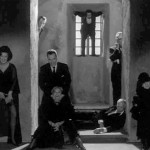Hour of the Wolf is Ingmar Bergman’s vampire film. Let me repeat that: Hour of the Wolf (1968) is Ingmar Bergman’s vampire film. I had no idea. Watching it for the first time on Saturday was one of those revelatory experiences in which my preconceptions were proven so utterly wrong that, midway through the film, I had to stop (not literally), gather my thoughts, and (I never thought I’d use this cliche to describe Bergman) enjoy the ride.
In many ways, Hour of the Wolf is the culmination of Bergman’s progression from the existential nightmare of Through a Glass Darkly to the absurdist imagery of The Silence and the self-conscious conceit of Persona. The story of a husband (Max von Sydow) and wife (Liv Ullman) driven to insanity amid the isolated landscape of Faro island, Hour of the Wolf is like a 90-minute version of the dream sequence in Wild Strawberries — a slow montage of ridiculously disconcerting imagery that is at once terrifying and beautiful. (Sven Nykvist did things with a camera that no one will ever match.) The “ghosts” who haunt the film are so frightening because they barely resemble ghosts at all. They simultaneously embody bourgeois banality and the sublime nothingness that, in Bergman’s formulation, will inevitably follow. Two parts 8 1/2-era Fellini, one part “Uncanny”-era Freud.
Like Carl Dreyer’s Vampyr (1932), I would call Hour of the Wolf one of the director’s lesser films — a rare instance in which Bergman’s style trumps his substance to just too great a degree. But I have a tendency to too easily dismiss works from the horror and gothic genres. I’m surprised, actually, that I was able to see this film without having ever read a bit about it. It’s just stunning to look at. Three days later, and I still can’t push some of its images from my mind.
